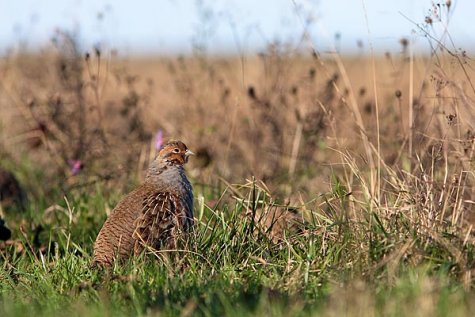Partridge flocks busy
Photo: Kaarel Kaisel
Translation: Liis
Partridge
|
Partridge |
Nurmkana ehk põldpüü |
Even on the ground the plant cover is quite transparent and the shielded life of partridges is much better visible. It can be worthwhile to watch sparsely weedy areas on cultured grounds and meadows and the seashore, and on harvested cereal fields there are plenty of spilled seeds.
The plumage of partridges is brown, the breast grey, tail rust-coloured – a quite good camouflage. The male has a brown patch on the belly; it is less noticeable on females and young birds, otherwise the plumages are similar, the young birds are just somewhat duller. Beak dark, legs grey and live weight about four hundred grams – the size of a young hen.
They are gallinaceous birds, living mainly on the ground, quite skilled in running and hiding. Like hens they scratch for food and even the calls are very similar. If danger threatens they fly a short distance and near the ground – a whirring flight, a brief glide and again a brief flight and they won’t go far. They land rather seldom in trees
At feeding they move with the neck stretched forward, the body is somehow hunched on scratching; they look for the seeds of weeds, the roots or tubers of plants, also insects or vertebrates and gravel for the crop for milling ...
The numbers of partridges are kept down by foxes, raccoon dogs, small predators, birds of prey and severe winters. During recent decades their numbers have decreased; up to five thousand pairs are estimated to be nesting.









